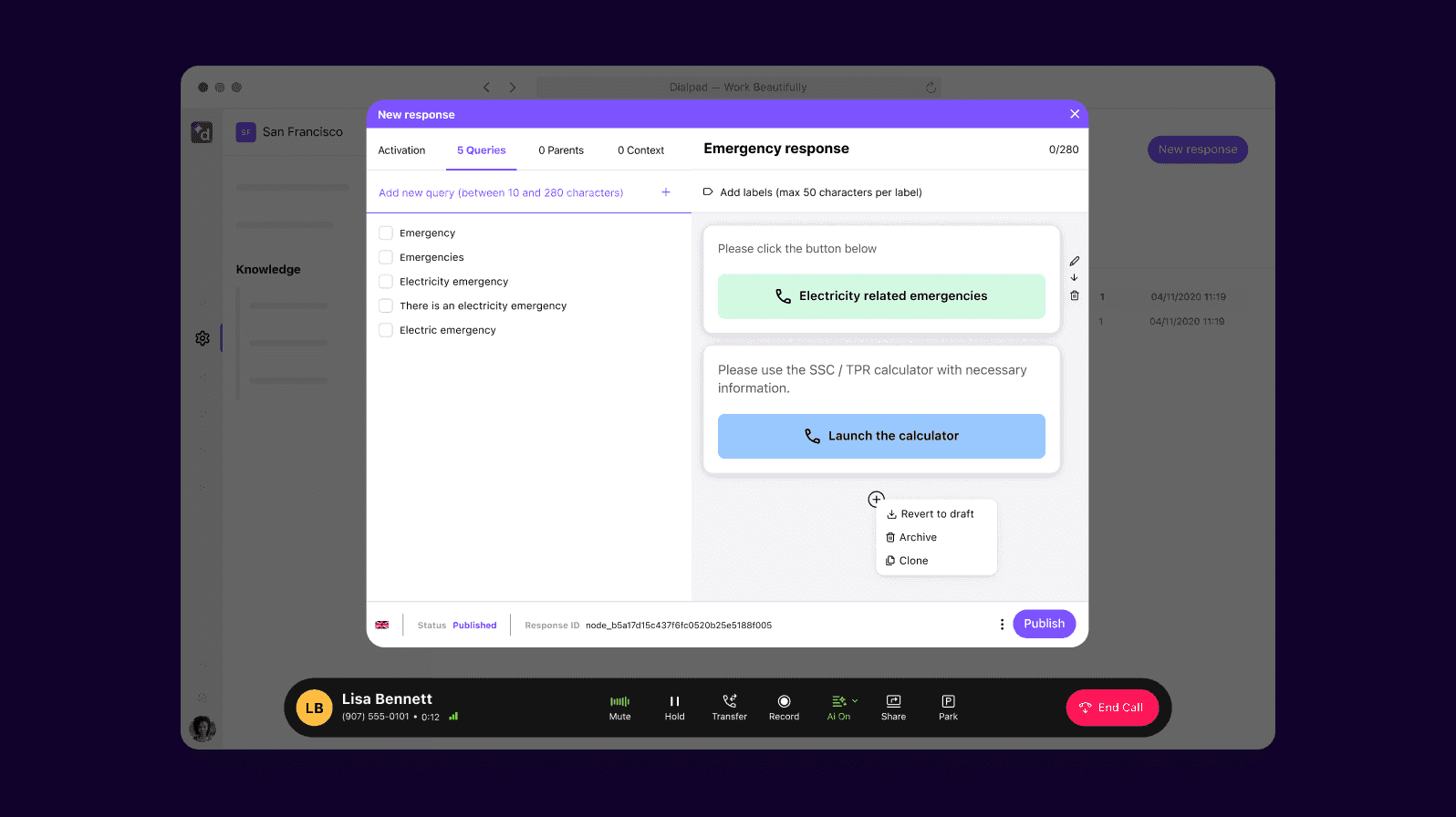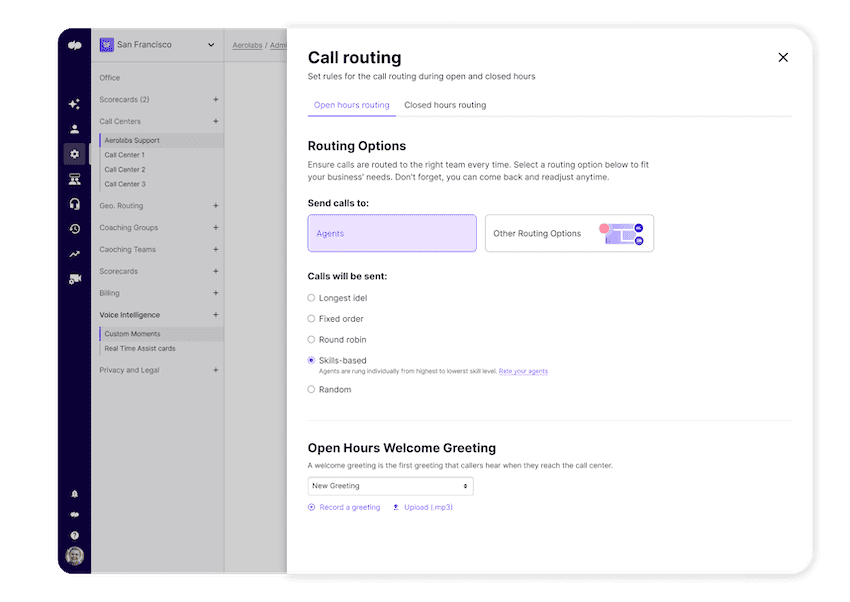From chatbots to agents: 6 real-world conversational AI examples

Sr. Product Marketing Manager

Tags
Share
Just a few years ago, talking to machines felt like something out of science fiction, whether it was HAL 9000 refusing to open the pod bay doors, Deep Thought calculating the meaning of life, or C-3PO translating in dozens of languages.
Today, those imagined interactions are pretty much reality—just with far more practical applications.
Conversational AI has quickly become a critical part of how businesses operate, especially in customer support, sales, and internal operations. With the rise of generative and agentic AI, companies aren’t just automating responses today—they’re deploying intelligent systems that can understand, respond, and even take action across channels without needing to be told what to do.
Whether through chat bots or agentic AI, conversational AI is essential for customer support today, helping customers and agents alike.
So, how are we using this amazing technology?
3 types of conversational AI
By using natural language processing (NLP) and natural language understanding (NLU), conversational AI can simulate human-like dialogue, resolve customer issues, and route inquiries—all without needing a human agent on the front lines. (Learn more about NLP in customer service.)
To begin, let’s first take a look at a few examples of conversational AI at work:
1. AI-powered chatbots
Yes, chatbots are the first (and perhaps most common) form of conversational AI. You may have had bad user experiences with companies through chatbots through social media channels like Facebook Messenger, WhatsApp, and Apple Business Chat.
Typically, these bad experiences would’ve had no conversational flow at all, mainly because they’re just very basic chatbots that react to different messaging prompts and your selection of predetermined answers. Maybe they just gave you a link to the Help Center and said “our agents are unavailable right now.”
But chatbot technology has evolved significantly past that point, and they can actually be good, helpful tools that use natural language understanding (NLU) and natural language generation (NLG) to interact with people using more human language.
One of the most common conversational AI chatbot examples is of course answering basic questions and looking up information without customers needing to speak to an agent. And it can all be done from a little pop-up window on a company’s website. With Dialpad's contact center platform, for instance, you can build one of these chatbot flows in just a few minutes with the no-code drag-and-drop builder:

2. Voice assistants
Is there a phone equivalent of an AI bot? Yes, and it’s called a voice assistant.
Voice assistants recognize voice commands and turn them into text entries for the AI, so that they can perform similar functions to AI chatbots. The most popular examples are Google Home, Amazon’s Alexa, and Apple’s Siri—they understand your speech, recognize your request, and perform an action based on it.
Think of voice assistants as convenient voice interfaces. They can carry out commands and reply to queries, making them helpful hands-free tools for looking up information or performing basic tasks.
3. Agentic AI
The newest evolution of conversational AI is agentic AI: autonomous digital agents capable of reasoning, planning, and taking multi-step actions without constant human prompting.
When you think of proactive conversational AI chatbot examples, agentic AI is the go-to solution. Unlike traditional chatbots or voice assistants that simply respond to isolated prompts, agentic AI can autonomously handle end-to-end tasks. For example, rather than just answering a support question, an agentic assistant can investigate the issue, gather relevant data from multiple systems, complete a workflow (like issuing a refund or rescheduling an appointment), and notify the user once it’s done.
These AI agents operate with a high level of autonomy and intelligence, often capable of dynamically adjusting their actions based on changing context. And as enterprise platforms increasingly integrate with other tools and LLMs, we’re seeing agentic AI used in more industries and for more use cases including customer support, IT help desks, HR onboarding, and internal operations automation.
In a contact center setting, this means AI is no longer just a helpful reactive tool. For instance, with a modern platform like Dialpad Support, agentic AI can analyze conversations in real time, suggest actions to agents, or even complete tasks on behalf of agents entirely.
Agentic AI represents a major shift from conversational to actionable AI—where conversations aren't just the interface, but the starting point for intelligent automation.
Conversational AI applications and examples in business
While AI isn’t quite at the point of being able to go out and grab your company’s executives a coffee (or even “tea, earl grey, hot”), it is an amazing tool for customer service. Here are just a few use cases for how businesses can use conversational AI platforms or apps today.
1. Book meetings or appointments with clients
One of the most valuable and time-saving applications of conversational AI (and now, agentic AI) is in booking appointments or services for customers. While early chatbots could handle simple scheduling (like offering a fixed list of available time slots and confirming a single selection), today’s AI solutions can manage the entire process end-to-end, with far more personalization and flexibility.
Think of the typical online appointment experience: you select a location, browse available times, choose a provider, and confirm. But what if no good times are available, or you need to change a detail midway through? Most systems force you to start over, creating friction that often leads to drop-off.
With conversational and agentic AI, that experience completely changes. Instead of navigating a rigid form, a customer can message, “I’m looking to book an appointment next week, here’s my availability and zip code,” and the AI will dynamically coordinate the best options. If their first choice isn’t available, it can automatically check alternate times, providers, or even nearby locations—without needing to be asked.
Because agentic AI can work with other integrated systems, it can do even more of these scheduling-related tasks, including:
Accessing your calendar and suggest ideal time slots based on real availability
Collecting relevant service history
Following up if additional information or prep is needed before the appointment
Take healthcare as an example. Instead of clicking through menus, imagine if a patient could just say, “I need to see someone about a knee issue,” and the AI would automatically review their insurance, check for relevant specialists, and offer appointment times—handling everything from triage to scheduling, without involving a human staff member.
2. Understand customer preferences to give them personalized suggestions
Have you ever seen a mobile ad and thought “my phone is clearly reading my mind?” That’s not telepathy, that’s algorithms determining what you want based on your past activity. For many ecommerce companies, this is one of the biggest advantages of conversational AI.
Imagine if a customer uses your AI chatbot to ask about a type of product. It could just pull up everything that’s similar to the product, or it could provide personalized recommendations based on the customer data and relationship history. The latter is more likely to make a sale and give the customer exactly what they’re looking for, whether it’s a premium service that matches their needs or a feature you know they like.
3. Answer FAQs and resolve general issues (without needing an agent)
One of the most common uses for conversational AI is to answer questions customers may have. These are typically simple for conversational AI to answer, because the information they need is all available and easily searchable in the company’s frequently asked questions.
Similarly, conversational AI can help resolve customer issues without them needing to speak to an agent.
A good AI can walk customers through troubleshooting steps, look up account details, and carry out basic tasks like upgrading subscriptions or editing accounts. If a customer has a billing question, the AI can check out their account and provide a breakdown of their charges. If they need help with an error they’re getting, the AI can give them a step-by-step process to address it.
This helps customers get resolutions more quickly, while freeing up agents for more pressing matters. This is also great for 24/7 self-service customer support, because AI technology can answer questions any time of the day and streamline workflows for agents by taking on those tasks.
4. Connecting callers with the right agent
What happens when a customer has a question that the AI system can’t answer? In that case, conversational AI can also help connect the caller to the agent best equipped to answer it.
The AI can learn what the caller’s concerns are or what questions they need answered, and then find out which agent has the skills and knowledge to resolve their issue.
As an example, think about conversational AI in financial services. A caller could call in with a simple question, like wanting to check their balance—the voice menu alone could help with that. But financial services is more than just banking. What if the caller has questions about specific investments, retirement planning, or insurance? The AI could understand their question, identify the agent with the best skills to help with that topic, and forward the call to that agent. That way every agent gets to provide financial advice for the topic they know the most about, and customers get the best help possible.
For instance, Dialpad Support has options for an interactive voice response (IVR) menu and skills-based call routing. (Plus it works across both a desktop and mobile app.) So callers can reach an interactive voice menu, and if the self-service options can’t answer their question, the call routing can direct them to the agent with the right skills to help them:

👉 Dialpad tip:
Dialpad AI can help contact centers with skills-based routing, agent availability, and call routing—see how CareRev uses it to reduce missed calls by 90%!
5. Lead generation and increased sales
Conversational AI is a powerful tool for driving lead generation and boosting sales by engaging prospects the moment they land on your website.
Instead of waiting for prospects to search through product pages or fill out contact forms, AI chatbots can proactively start a conversation, answer questions, recommend products, and guide them through the decision-making process in real time. This not only shortens the sales cycle, but also creates a more personalized and interactive customer experience.
For example, when a potential buyer visits an ecommerce site, a conversational AI assistant can ask what they’re looking for, highlight best-selling items, surface relevant content or reviews, and even offer promotions—all based on their behavior and preferences. The result? Higher engagement, longer time on site, and increased chances of conversion.
With agentic AI, this goes even further because it can:
Automatically qualify leads based on responses
Collect key information for sales teams
Schedule demos or consultations without human input
Integrate directly with CRM tools to update contact records in real time
6. Employee training and development
Conversational AI isn’t just for customers—companies can also use it for employee training. Supervisors can use AI to analyze phone calls for customer sentiment, uncover insights from transcriptions, and provide agents with important information while they’re talking with a customer (like with Dialpad’s AI Live Coach Cards, which pop up during a call whenever Dialpad AI hears a preset keyword to give agents relevant information):

It can even automatically search your company's knowledge base and unstructured sources of data (like PDF documents) to find answers to support agents.
How to provide a better customer experience with these examples of conversational AI
What’s next for conversational AI? As the technology evolves and AI continues to learn through deep learning, it’ll be able to better understand user intent, provide more appropriate responses to customer queries, and offer more human-like conversational experiences that aren’t just based on rigid rule-based scripts.
Right now AI can resolve a pretty wide range of customer interactions and perform minor tasks. But give it time and development, and it’ll be able to move past that. For instance, providing customers with troubleshooting steps will evolve into being able to diagnose an issue and walk the customer through the process even when things don’t work as expected, highlighting one of the many reasons why AI is good.
This will also extend to speech recognition and analytics. As we continue to use conversational AI chatbots, machine learning enables it to expand its knowledge and improve the accuracy of its automatic speech recognition (ASR). That’ll give us more accurate transcriptions, better understanding of customers’ needs, and new ways to find information for agents.
One thing AI solutions won’t do is replace human interaction altogether. There will always need to be human agents ready to handle more complex cases, or provide that element of human conversation that even AI can’t. But as AI develops to handle a wider variety of queries, it’ll help customers get the help they need more quickly while freeing up agents for the bigger tasks.
These are just a handful of AI in business examples and as conversational AI continues to grow, we’ll keep finding new ways to improve Dialpad AI for business communications across all industries.
See how Dialpad AI works
Get a demo of Dialpad Support and see how customer support and sales teams are using the conversational AI functionality. Or, take a self-guided interactive tour of the app on your own first!
